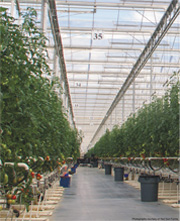~ Greenhouse-Grown is not GMO ~
One of the toughest challenges in the greenhouse industry has little to do with production or distribution, however; many growers have encountered pushback from retailers and consumers who are mixing up technical jargon, confusing greenhouses with high tunnels or other structures, or even equating greenhouse-grown produce with genetic modification.
Paivarinta agrees there is ‘lingering confusion’ about what is and isn’t a greenhouse even among receivers and retailers, as well as consumers. “The latest tomato suspension agreement went a long way towards defining, ‘controlled versus adapted’ environments, but the industry must do a better job communicating the different technologies and infrastructure employed in true greenhouse production.”
Wowryk believes better marketing will turn this hindrance into an advantage. “Some of the more common misconceptions about greenhouse growing are centered around the scientific aspect of hydroponic produce—some people think of [workers] in white hazmat suits and that it’s ‘Frankenfood’—which is incredibly far from the truth.” Other misconceptions include the belief that greenhouse vegetables are “artificial” and lack the flavor of a field-grown tomato or one grown in the backyard.
“The product is consistent in production, size, shape, and for the most part, taste,” Wowryk explains. And because greenhouses can grow year round, unlike their field counterparts, there is steady, reliable production. “The produce is grown in a climatically-controlled environment, providing heat when needed. When the plants need water and nutrients, they are automatically fed. Just because this is all done in a scientific and efficient way doesn’t change that this is all-natural produce; we just need to change the public perception of greenhouse fruits and vegetables,” he emphasizes.
~ Final Thoughts ~
Greenhouse growing is here to stay, and most of its challenges are good problems to have—adapting to new technologies, finding new ways to use them, and conditioning a traditional market to an expansion of the growing season and a new way of doing business for shippers and distributors.
And although misconceptions do exist, growers can educate consumers through better marketing—including print, online, and mobile, as well as in stores with displays and informative packaging. Helping consumers differentiate between various types of protected agriculture—including greenhouses and growing techniques such as hydroponics as well as other types of enclosed and semi-enclosed structures—will ultimately benefit all. Lastly, dispelling myths about IPM, bio-agents, and genetic modification are key to expanding greenhouse-grown produce sales.
But, as more and more regions follow Ontario’s lead—Quebec and British Columbia are already significantly ramping up their greenhouse production—and more and more companies expand their reach into the United States, Mexico, and Central America, it will all come down to the quality of the product, and those in the industry have no qualms about that.
“Some of the most flavorful tomato varieties in the market are greenhouse grown,” boasts Wowryk.



